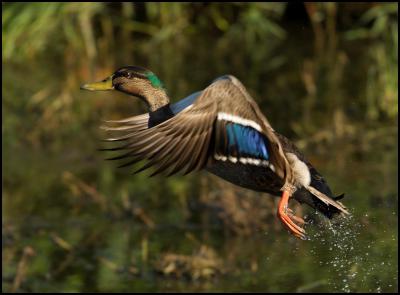Game bird season round country holds ‘strong prospects’
20 April 2017
Immediate Use
Game bird season round country holds ‘strong prospects’

Mallard on the wing (Photo
courtesy Jeanette Nee)
Fish & Game staff are predicting a very strong start to the new game bird season in some parts of both the North and South islands thanks to the wet spring and summer.
In some regions, the wet spring conditions which extended into summer provided ideal conditions for ducks to breed and raise their ducklings.
Game bird hunters in Fish & Game’s large Eastern Region can expect one of the best hunting seasons for some time, going by the latest research into bird numbers.
The Eastern Region covers a big chunk of the central North Island, taking in areas including the East Coast, Tauranga, Taupo, the Rangitaiki Plains, and Rotorua lakes district.
Senior Fish & Game Officer Matthew McDougall says Fish & Game is predicting “a better season than we’ve had for the last seven or so years.”
Mr McDougall says this is based on duck numbers trapped over summer within the Eastern region for research, and banding data collected over a 20 year period.
“We trapped 1,500 ducks in total this year which is more than we have in any of the preceding years of trapping and banding.”
Mr McDougall says that what trapping and population modelling tells us is that there are “lots of ducks around in reasonable condition, and we’re predicting that this opening could be one of the best in years.”
Fish & Game’s research, which has included aerial flyovers to estimate bird numbers, indicates a mallard population in the order of 350,000 to 450,000 birds.
Fish & Game’s harvest regulations are set according to estimated duck numbers, and this year’s region wide estimate falls into the “intermediate” zone in which a six week season and daily bag limit of eight birds applies, he says.
Numbers within the Reporoa area however are of some concern and the Eastern Fish and Game Council has decided to impose more restrictive conditions there, with a shorter season which runs from Opening Day on May 6 to June 5 with a daily bag limit of four mallards.
In the neighbouring Auckland-Waikato Region, it’s also a “good news” story.
Staff say that while the catch rates at banding sites don’t always correspond to population levels, it was pleasing to see large number of birds at all the sites this year.
Mallard numbers were healthier than they’ve seen for some time, up an average 20 to 25% across the board.
In Taranaki, mallard and grey duck populations are also in “very good heart.” Staff say they won’t be surprised if it’s “one of the best seasons for some years.” On the other coast,Hawke’s Bay staff are also optimistic after a “fairly decent breeding season.”
Further south in Wellington, prospects for opening are described as “looking good.”
Fish & Game staff say the wetter than normal weather has provided ample habitat for breeding and duckling rearing and, based on field observations, it’s hoped that plenty of double broods will boost the number of ducks around for Opening Day.
Strongly optimistic reports have also been received from at least a couple of South Island regions.
Otago staff say prospects are “damn good” with the traditional duck hunting strongholds of South and West Otago looking especially strong.
In Nelson Marlborough, duck numbers are up after an excellent breeding season. Fish & Game staff have pointed to “a nice wet spring which meant lots of puddles for ducklings and great survival rates with even multiple clutches reported.”
On the Canterbury Plains, mallards are present in “moderate numbers” said to be on par with previous seasons but slightly higher than average in the Central South Island region.
Both North Canterbury and Central South Island regions have good numbers of paradise shelducks, and North Canterbury has strong numbers of black swans.
In Southland staff advise locals who’re starting to feed their ponds to help attract ducks for fast approaching Opening Weekend, to include some sort of predator control programme.
“After six weeks of pre-feeding and putting game cameras on the feeders to monitor how much interest we were getting from ducks, we captured hundreds of rat photos, a stoat and several feral cats,” says Southland Fish & Game manager Zane Moss.
“It makes sense - if you are attracting ducks to
an area, you are also attracting
predators.”


 University of Auckland: Tributes Flow For Much Loved Pacific Leader Melegalenu’u Ah Sam
University of Auckland: Tributes Flow For Much Loved Pacific Leader Melegalenu’u Ah Sam NZEI: Ministry Of Education Cuts Will Disproportionately Affect Pasifika
NZEI: Ministry Of Education Cuts Will Disproportionately Affect Pasifika Day One Hapai te Haeata: Call To Action For Young Filmmakers Against The Backdrop Of Funding Cuts
Day One Hapai te Haeata: Call To Action For Young Filmmakers Against The Backdrop Of Funding Cuts Toyota New Zealand: Three Races For Top Three To Decide TR86 Title
Toyota New Zealand: Three Races For Top Three To Decide TR86 Title Wellington City Council: Wellington Is All Action Stations For The Faultline Ultra Festival
Wellington City Council: Wellington Is All Action Stations For The Faultline Ultra Festival Melanie Allison: Local Playwright Casts A Spell Over Hamilton
Melanie Allison: Local Playwright Casts A Spell Over Hamilton